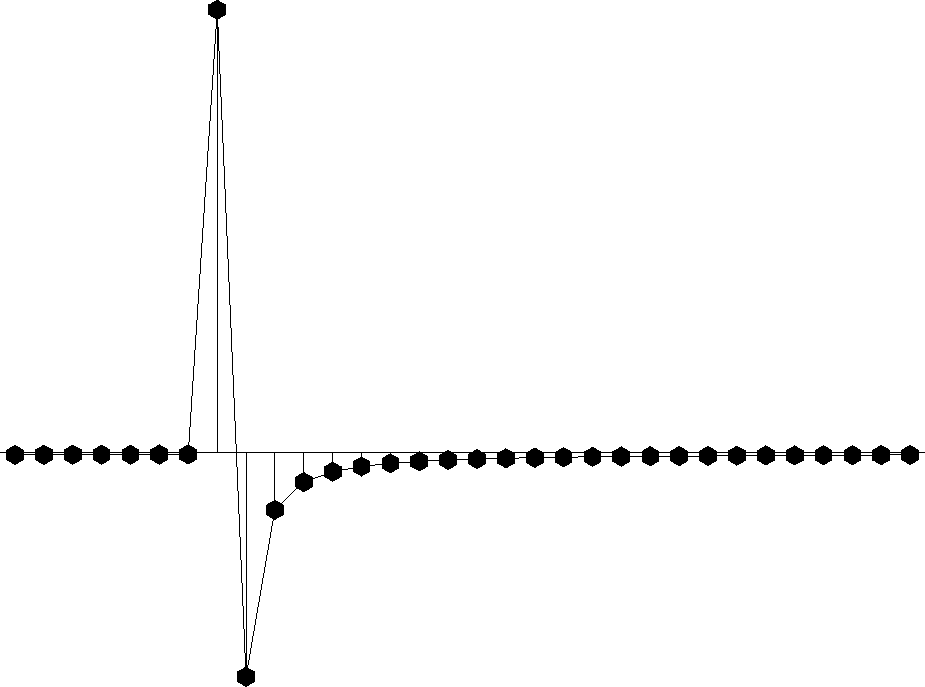The waveform in equation (31) often arises in practice
(as the 2-D Huygens wavelet).
Because of the discontinuities on the left side of equation (31),
it is not easy to visualize.
Thinking again of the time derivative
as a convolution with the doublet ![]() ,we imagine the 2-D Huygen's wavelet as a positive impulse followed
by negative signal decaying as -t-3/2.
This decaying signal is sometimes called the ``Hankel tail.''
In the frequency domain
,we imagine the 2-D Huygen's wavelet as a positive impulse followed
by negative signal decaying as -t-3/2.
This decaying signal is sometimes called the ``Hankel tail.''
In the frequency domain
![]() has a 90 degree phase angle and
has a 90 degree phase angle and
![]() has a 45 degree phase angle.
has a 45 degree phase angle.
# Half order causal derivative. OK to equiv(xx,yy)
#
subroutine halfdifa( adj, add, n, xx, yy )
integer n2, i, adj, add, n
real omega, xx(n), yy(n)
complex cz, cv(4096)
n2=1; while(n2<n) n2=2*n2; if( n2 > 4096) call erexit('halfdif memory')
do i= 1, n2 { cv(i) = 0.}
do i= 1, n
if( adj == 0) { cv(i) = xx(i)}
else { cv(i) = yy(i)}
call adjnull( adj, add, xx,n, yy,n)
call ftu( +1., n2, cv)
do i= 1, n2 {
omega = (i-1.) * 2.*3.14159265 / n2
cz = csqrt( 1. - cexp( cmplx( 0., omega)))
if( adj != 0) cz = conjg( cz)
cv(i) = cv(i) * cz
}
call ftu( -1., n2, cv)
do i= 1, n
if( adj == 0) { yy(i) = yy(i) + cv(i)}
else { xx(i) = xx(i) + cv(i)}
return; end
In practice, it is easiest to represent
and to apply the 2-D Huygen's wavelet in the frequency domain.
Subroutine halfdifa() ![[*]](http://sepwww.stanford.edu/latex2html/cross_ref_motif.gif) is provided for that purpose.
Instead of using
is provided for that purpose.
Instead of using ![]() which
has a discontinuity at the Nyquist frequency
and a noncausal time function,
I use the square root of a causal representation
of a finite difference, i.e.
which
has a discontinuity at the Nyquist frequency
and a noncausal time function,
I use the square root of a causal representation
of a finite difference, i.e. ![]() ,which is well behaved at the Nyquist frequency
and has the advantage that the modeling operator is causal
(vanishes when t<t0).
Fourier transform is done using subroutine ftu()
,which is well behaved at the Nyquist frequency
and has the advantage that the modeling operator is causal
(vanishes when t<t0).
Fourier transform is done using subroutine ftu() ![[*]](http://sepwww.stanford.edu/latex2html/cross_ref_motif.gif) .
Passing an impulse function into subroutine halfdifa()
gives the response seen in Figure 7.
.
Passing an impulse function into subroutine halfdifa()
gives the response seen in Figure 7.
|
hankel
Figure 7 Impulse response (delayed) of finite difference operator of half order. Twice applying this filter is equivalent to once applying (1,-1). |  |